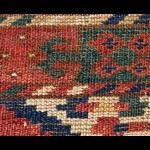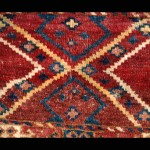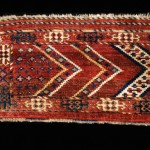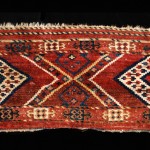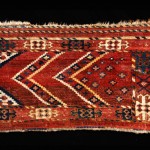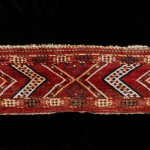A Shaman’s Trapping
Once in a lifetime a Turkman weaving might come along that breaks all the traditional rules offering a rare insight into the religious and spiritual lives of those fierce nomadic horsemen. This ersari trapping is like a Turkman ‘Rosetta stone’ for me.
Superficially, this is an Ersari trapping made with very soft wool and a nice range of natural dyes. The piece has aged and mellowed out underneath a hot sun. The dyes are all unique and obviously the work of a master dyer. The yellow is warm and still potent helping to create an incredibly rich aqua blue-green, that can be like sea-blue one minute and clear green the next. The reds range from an intense cherry red to a rich earthen brown, an incredible range really. Trappings are woven without backs and served as the aesthetic and social advertisements for individuals.
It is my theory that a shaman wove this unique Ersari trapping. I base this theory mostly on the head and shoulders “realistic” representation or picture of a shaman, in up and down vertical reflection, at the center of this weaving. I have studied shamanic practices around the world and I have noticed that shamen often draw extremely minimalistic pictures of their heads on cloth that is then worn as a head-band, with their shamanic spirit image centered on the forehead.
The modern thinking is that Turkmen weavers generally didn’t have any deep understanding of the meanings of their various designs. This has led to the idea that perhaps shamen and or perhaps khans were the true repositories of such sacred ideas and teachings.
I think my unique ersari trapping supports this new thinking. I see in it the work of a weaver who could take apart the essence of one distinctive genre of ersari design, in the chuval format, and then reassemble the shards of that design into a very potent and totally new arrangement of designs in trapping format. In musical terms this might represent the transposing of cerebral harp music into an improvisational jazz piano sketch.
The goal driven rearrangement of old designs, to meet personal and unique circumstances, reveals the confidence and familiarity I would expect any competent shaman to possess.
I suspect it was woven within the region of the Akhal Oasis. I base this location on the wool quality, the dye quality / colors, and the specific “closure” of the main border by the extension of a segment of the inner minor border. I have seen this same ‘closure’ feature on several Tekke torbas that were clearly from the Akhal Oasis based on color, wool quality, and structure.
“The Akhal Oasis is a strip of land flanked by the Caspian Sea, a desert, and mountains. As such it was quite isolated, had little by way of hinterland, and was not on a trade route as was Merv. The arable land fringe, immediately north of the mountains and colloquially known as the “Skirt” (Atek), was watered by rivers and streams coming down from the mountains and creating a series of oases. This wonderful arable land was an isolated Turkman haven and Tekke tribal traditions were well maintained till late in the 19th century.”
I associate the isolated nature of the Akhal Oases and its supreme self-sufficiency with the closure of the main border. This feature is seen in many Akhal Oasis torbas and is created by an extension of the inner minor border until it touches the outer minor border. I interpret this design feature as saying “we live in this closed off part of the world that we protect from all outsiders.” I don’t recall ever seeing such a border-closing feature on any Turkman weaving from outside the Akhal Oases. Richard Wright has published a paper on the collected writings about the Akhal Oases and it is a good read. The quote above is from his paper.
I said that a shaman wove this trapping and I find reinforcing evidence in the many unique design features I find in the weaving. First consider the intentional color break in the background field color. This profound change in color creates an internal horizon and adds depth to the composition. The weaver has placed an “evil eye” element at the same level in both vertical border segments positioning them directly over the internal horizon created by the color break, to ostensibly give these two evil eyes even more emphasis and significance.
I find it most effective to stand back from this trapping, or its image, until I can just see both “evil eyes” at the same time. At this distance the inner drive of the inwardly pointing chevron shapes take on a new significance. The action begins in the field with two inwardly pointing pentagonal areas cut off at the left and right sides. These pentagonal forms are filled with a variety of small cross forms that seem to be literally suspended in the air. I believe that all Turkmen shamans used drums in their work. The drumming of the shaman’s drum was deemed to be something alive and full of power.
Just for fun imagine those multiple cross forms, filling each pentagonal lateral form, as particles of suspended dust and then those four inwardly pointing chevron shapes as sound waves, carrying the “dust” inwardly towards the shaman. This idea is supported by the appearance of all the same cross elements, found in the outer most pentagonal forms, in three inwardly pointing chevron shapes, as if the sound waves from the drum had picked them up and was carrying them inward, literally to a point in the brain.
I want to come back to this point but I need to explain the two largest inwardly pointing chevron shapes. These two larger chevrons have a white background signaling their supreme importance to the composition. These two largest chevrons are filled with an arrangement of dumb-bell shaped designs. This design represents a humming bird, when it is seen head on. I see hummingbirds daily and when they are suspended in air looking at me this is what they really do look like as a minimalist representation.
In a native milieu this design was heard as a buzzing or whirring by those Turkmen who saw it. If you can imagine the scene in a shaman’s yurt as a shaft of light passes through the sky-hole to illuminate an atmosphere full of suspended particles of dust. The particles are moved about as the shaman drums his drum, and this trapping, there suspended on a wall, represents everything in the scene.
The idea about the “humming” birds comes from a study I did many years ago on the so-called “singing arrow” ersari group chuvals. These chuvals have a bilaterally arranged set of “W” forms. Where the two “W” forms approach each other in the mid-line an inner segment of geometric space is cut out. The central most design usually portrays a bow with an arrow in reflection, itself encompassing an archaic design. In the oldest examples of this genre, some if not all of the “W” forms are filled with a series of designs made up of a dominant circular form surmounted by an off center smaller circular form plus a slightly curving “beak”. When I finally realized that these pictograms were indicating humming birds, as seen from their sides, I could then “hear” the design. It was for this reason that I named the group, “singing arrow”.
There is an excellent illustration of the “singing arrow” type of Ersari chuval in Loges, figure 101, page 166-167. Also in Loges there is an ensi, figure 85, whose prominent central panel is a slightly smaller version of this shaman trapping’s design. Does the Loges ensi’s central panel indicate that it served as the decoration for a powerful shaman’s portal? I would think so!
The design intent of my shaman’s trapping boils down to its visual conclusion just above and below the center point of its composition. Standing back from the weaving until one sees both metaphoric “evil eyes” positioned just outside the lateral pentagonal shapes, imagine those inwardly pointing chevron shapes as sound waves carrying dust particles inwardly colored by the whirring sounds of humming birds to a meeting place in the brain. There, at the intersection of all the input from the right and left hemispheres, two triangular spaces are de-facto defined. In these two triangular spaces, positioned above and below the central horizontal plane of the weaving, are two ‘head and shoulder’ representations of the shaman. The shoulders are the key to this assertion. The shoulders have a distinctive hump to them and they are more finely knotted than any other part of the piece. The face is created using simple cross forms as the eyes, the mouth, and a third eye. This representation of the shaman’s face is simplistic, as they usually are, but remember, there are strong prohibitions in Islam concerning any representation of the living, so a believable deniability was perhaps desirable.

